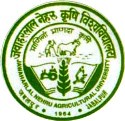
Located in the heart of India, named after the architect of modern India, Pt. Jawaharlal Nehru, a multi-campus University, Jawaharlal Nehru Krishi Vishwa Vidyalaya (JNKVV) was inaugurated by the then Union Minister for Information and Broadcasting Smt. Indira Gandhi on October 2, 1964. At present, JNKVV encompasses four Agriculture Colleges (Jabalpur, Rewa, Tikamgarh, Ganjbasoda); one Agricultural Engineering College (Jabalpur); 4 Zonal Agricultural Research Stations (ZARS) (Jabalpur, Powarkheda, Tikamgarh, Chhindwara); 2 Regional Research Stations (Rewa, Sagar); 5 Agricultural Research Stations (ARS) (Dindori, Waraseoni, Garhakota, Sausar, Tendini) and 20 Krishi Vigyan Kendras (KVK) (Badgaon, Betul, Chhattarpur, Chhindwara, Damoh, Dindori, Harda, Jabalpur, Katni, Mandla, Narsinghpur, Panna, Powarkheda, Rewa, Sagar, Seoni, Shahdol, Sidhi, Tikamgarh, Umaria) in 6 agro-climatic zones spread over 25 districts of the State. The University occupies an area of about 1,554 ha. JNKVV represents a well knit and action oriented network of research and education centres in agriculture and allied fields in the State. More than four decades of its existence, it has developed a sound infrastructure and human resources which make it capable of addressing emerging technological challenges in agriculture. JNKVV has produced competent human resource for managing the activities of agriculture and allied sectors and also played a pivotal role in the growth and development of agriculture in the State. Need based research and its dissemination to the peasantry have led to all round improvement in productivity of crops on sustainable basis. Madhya Pradesh is situated in the center of India and bounded on all around by other states. A population of 6,03,85,118 lives in 55393 villages, 285 tehsil, 313 blocks, 45 districts and 10 divisions spread over 308 thousand sq. km geographical area between 21'80 to 26'520N latitude and 74'20 to 82'0E longitude, which is divided by Tropic of Cancer. Nearly 80% of the State population lives in villages. Madhya Pradesh has the largest population of Scheduled Tribes among all the states. The major tribes are Gonds, Bhills, Oraons, Korkens and Kols. Twenty three districts are predominantly tribal. The climate is extreme in the north, temperate and breezy in the plateau and generally hot and humid in the eastern and southern plains. The over all climate varies from semi-arid to sub-humid with hot summer, cool and dry winter with 600-1600 mm mean rainfall range. It is a part of the Deccan Plateau and comprises plateaus and low hills. Except for the valley of Narmada and Tapti, Madhya Pradesh consists of plateaus with mean elevation of 1600 feet above mean sea level, interspread with the mountains of the Vindhya and the Satpura ranges. The maximum height of 1350 m is recorded in Satpura range on the other hand 150 m height is found in Chambal valley. The main river systems are the Betwa, Chambal, Narmada, Sindh and Tapti. Nearly a third of the states area is covered with tropical forest. The economy of the State is primarily agriculture based. Over 75% of people are engaged in agriculture. Over 52.06% of the land area is cultivable. The Malwa region abounds in rich black cotton soil, the low lying areas of Gwalior, Bundelkhand and Baghelkhand have light soil, whereas the Narmada valley is formed of deep rich alluvial deposits. The main food crops are sorghum, wheat, rice and coarse grain such as Kodo, little and Italian millets. Important among commercial crops are pulses, oilseeds, cotton, sugar cane and medicinal crops. The state is poised for a breakthrough in soybean cultivation. First in soybean, oilseed, chickpea and maize production in the country. In the State, Kharif crops occupy 60% and rabi crops 40% area with 71.4 % area under food grain production. Nearly 59% of landholders are marginal, whereas small farmers share 18% of farmland. Low literacy (35.45%), undulating topography, large waste land (13.2%), under developed irrigation potential (23%), low ground water utilization, large proportion of rain fed agriculture (75%), practice of Kharif fallow (3.6%), low cropping intensity (126%), low fertilizer consumption (31 kg/ha), high proportion of low value crops, and high population of low productive live stock are the major constraints of the state.